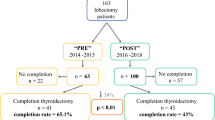Abstract
Background
At our institution, thyroid lobectomy is employed as a definitive operation for unifocal intrathyroidal low risk cancers and thus completion thyroidectomy is rarely performed. The purpose of this study was to identify the indications for selective completion thyroidectomy and to report oncologic outcomes.
Methods
A retrospective review was performed to identify patients who underwent planned completion thyroidectomy for well-differentiated thyroid carcinoma (WDTC) from 2001 to 2010 based on initial lobectomy pathology. Assessment for risk of recurrence was based on the American Thyroid Association Initial Risk Stratification.
Results
During the 10-year study period, 79 patients underwent completion thyroidectomy for WDTC. Forty-four (56 %) patients were low risk and 35 (44 %) were intermediate risk. Completion thyroidectomy was recommended for 64 patients, whereas 15 patients were given an option of surveillance but ultimately decided to have surgery. Patients in the “recommended group” had more T3 tumors and fewer T1a tumors (p = 0.005 and 0.006, respectively). These patients also were more likely to be intermediate risk (p = 0.008) and to present with aggressive histology (p = 0.002). The rate of contralateral tumors (n = 27) was similar between both groups (35 and 33 %, respectively). Contralateral cancers were micropapillary in 24 of 27 (89 %) patients, 10 (40 %) of whom had multifocal disease. There were two pulmonary recurrences and no local-regional recurrences (median follow-up of 42.3 months).
Conclusions
Completion thyroidectomy is infrequent and performed for a select group of intermediate and low risk WDTCs at our institution with low recurrence rates. Incidental multifocal and unifocal contralateral cancers are common after completion thyroidectomy.

Similar content being viewed by others
References
Shaha AR, Jaffe BM. Completion thyroidectomy: a critical appraisal. Surgery. 1992;112(6):1148–52; discussion 1152–3.
Shaha AR. Completion thyroidectomy: fact or fiction? Am J Otolaryngol. 2011;32(5):448–9.
Hassanain M, Wexler M. Conservative management of well-differentiated thyroid cancer. Can J Surg. 2010;53(2):109–18.
American Thyroid Association Guidelines Taskforce on Thyroid N, Differentiated Thyroid C, Cooper DS, et al. Revised American Thyroid Association management guidelines for patients with thyroid nodules and differentiated thyroid cancer. Thyroid. 2009;19(11):1167–214.
Shah JP, Loree TR, Dharker D, Strong EW. Lobectomy versus total thyroidectomy for differentiated carcinoma of the thyroid: a matched-pair analysis. Am J Surg. 1993;166(4):331–5.
Mazzaferri EL, Jhiang SM. Long-term impact of initial surgical and medical therapy on papillary and follicular thyroid cancer. Am J Med. 1994;97(5):418–28.
Bilimoria KY, Bentrem DJ, Ko CY, et al. Extent of surgery affects survival for papillary thyroid cancer. Ann Surg. 2007;246(3):375–81; discussion 381–4.
Nixon IJ, Ganly I, Patel SG, et al. Thyroid lobectomy for treatment of well differentiated intrathyroid malignancy. Surgery. 2012;151(4):571–9.
Tuttle RM, Tala H, Shah J, et al. Estimating risk of recurrence in differentiated thyroid cancer after total thyroidectomy and radioactive iodine remnant ablation: using response to therapy variables to modify the initial risk estimates predicted by the new American Thyroid Association staging system. Thyroid. 2010;20(12):1341–9.
Tollefsen HR, Shah JP, Huvos AG. Papillary carcinoma of the thyroid: recurrence in the thyroid gland after initial surgical treatment. Am J Surg. 1972;124(4):468–72.
Shaha AR, Shah JP, Loree TR. Low-risk differentiated thyroid cancer: the need for selective treatment. Ann Surg Oncol. 1997;4(4):328–33.
Nixon IJ, Ganly I, Patel SG, et al. The results of selective use of radioactive iodine on survival and on recurrence in the management of papillary thyroid cancer, based on Memorial Sloan-Kettering Cancer Center risk group stratification. Thyroid. 2013;23(6):683–94.
Tuttle RM, Sabra MM. Selective use of RAI for ablation and adjuvant therapy after total thyroidectomy for differentiated thyroid cancer: a practical approach to clinical decision making. Oral Oncol. 2013;49(7):676–83.
Vaisman F, Shaha A, Fish S, Tuttle R. Initial therapy with either thyroid lobectomy or total thyroidectomy without radioactive iodine remnant ablation is associated with very low rates of structural disease recurrence in properly selected patients with differentiated thyroid cancer. Clin Endocrinol. 2011;75:112–9.
Pasieka JL, Thompson NW, McLeod MK, Burney RE, Macha M. The incidence of bilateral well-differentiated thyroid cancer found at completion thyroidectomy. World J Surg. 1992;16(4):711–6; discussion 716–7.
Sakorafas GH, Giotakis J, Stafyla V. Papillary thyroid microcarcinoma: a surgical perspective. Cancer Treat Rev. 2005;31(6):423–38.
Turanli S, Aslan S, Cetin A. Clinical significance of residual occult malignancy in thyroid carcinoma. Am J Otolaryngol. 2011;32(5):398–401.
Londero SC, Krogdahl A, Bastholt L, et al. Papillary thyroid microcarcinoma in Denmark 1996–2008: A National Study of Epidemiology and Clinical Significance. Thyroid. 2013;23:1159–64.
Grigsby PW, Reddy RM, Moley JF, Hall BL. Contralateral papillary thyroid cancer at completion thyroidectomy has no impact on recurrence or survival after radioiodine treatment. Surgery. 2006;140(6):1043–7; discussion 1047–9.
Conflict of interest
None.
Author information
Authors and Affiliations
Corresponding author
Rights and permissions
About this article
Cite this article
Untch, B.R., Palmer, F.L., Ganly, I. et al. Oncologic Outcomes After Completion Thyroidectomy for Patients with Well-Differentiated Thyroid Carcinoma. Ann Surg Oncol 21, 1374–1378 (2014). https://doi.org/10.1245/s10434-013-3428-1
Received:
Published:
Issue Date:
DOI: https://doi.org/10.1245/s10434-013-3428-1




